change wheel AUDI A3 2012 Owner´s Manual
[x] Cancel search | Manufacturer: AUDI, Model Year: 2012, Model line: A3, Model: AUDI A3 2012Pages: 280, PDF Size: 70.11 MB
Page 216 of 280

214 Tires and wheels
Maximum loaded vehicle weight
means the sum of:
(a) Curb weight
(b) Accessory weight
(c) Vehicle capacity weight, and
(d) Production options weight
Maximum (permissible) inflation pressure
means the maximum cold inflation pressu re
to which a tire may be inflated. Also called
"maximum inflation p ressure."
Normal occupant weight
means 150 lbs. (68 kilograms) times the
number of occupants seated in the vehicle up
to the total seating capacity of your vehicle.
Occupant distribution means distribution of occupants in a vehicle .
Outer diameter means the overa ll diameter of an inf lated new
tire.
Overall width
means the linear distance between the exteri
ors of the sidewalls of an inflated tire, includ
ing e levations due to labeling, decorations, or
protective bands or ribs.
Ply
means a layer of rubber-coated parallel cords.
Production options weight
means the comb ined weight of those installed
regular production options weighing over 5
lbs . (2 .3 kg) in excess of those standard items
which they replace, not previously considered
in curb weight or accessory weight, including
heavy duty brakes, r ide leve lers, roof rack,
heavy duty battery, and specia l trim .
Radial ply tire
means a pneumatic tir e in which the p ly cords
that extend to the beads are laid at substan
tially 90 degrees to the centerline of the
tread . Recommended inflation pressure
see
~
page 213, Cold tire inflation pressure.
Reinforced tire
means a t ire designed to operate at higher
loads and at higher inflation pressures than
the corresponding standard tire . Re inforced
t ir es my be identified as "XL", "xl", "EX TRA
LOAD", or "RF" on the sidewall.
Rim
means a metal support for a tire or a t ire and
tube assembly upon which the tire beads are seated.
Rim diameter
means nom inal d iameter of the bead seat. If
you change your wheel s ize, you w ill have to
purchase new tires to match the new r im di
ameter .
Rim size designation
means rim diameter and width.
Rim width
means nominal distance between rim flanges .
Sidewall
means that portion of a tire between the
t read and bead.
Speed rating (letter code)
means the speed at which a tire is designed to
be driven for extended periods of time. The
ratings range from 93 mph (150 km/h) to
186 mph (298 km/h)
~ page 224 . You may
not find this information on all tires because
it is not requ ired by law.
The speed rating letter code, where applica
ble, is molded on the tire sidewall and indi
cates the max imum pe rmissibl e road speeds
~ A in Winter tires on page 228.
Tire pressure monitoring system*
means a system that detects when one or
more of a veh icle's tires are underinflated and
illuminates a low tire pressure warning tell
tale.
Page 219 of 280
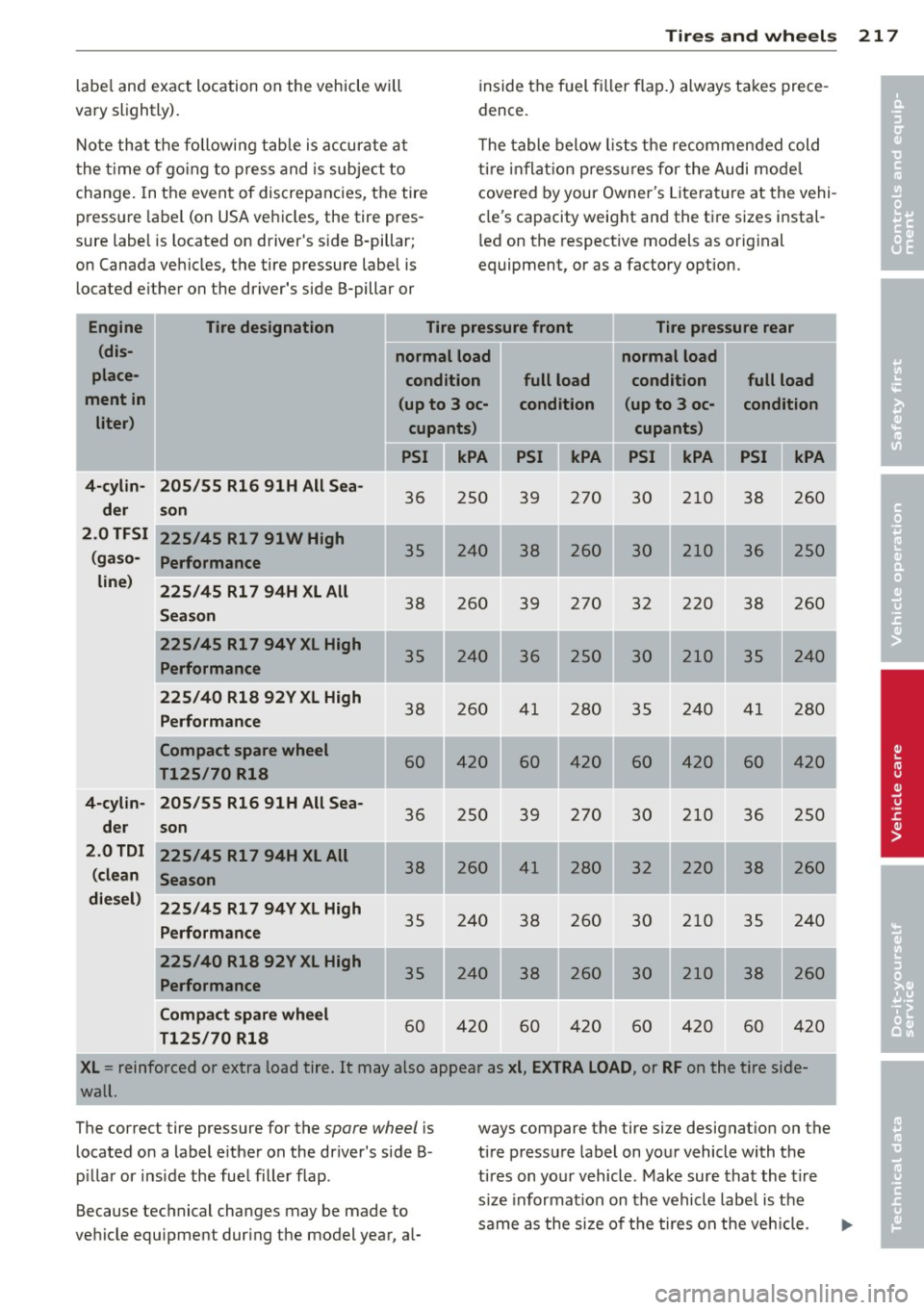
Tires an d wheel s 21 7
labe l and exact location on the vehicle will
vary slightly).
Note that the fo llowing tab le is accurate at
t he t ime o f go ing to press and is subject to
change. In the event of discrepancies, the tire
pressure label (on USA vehicles, the tire pres
sure label is located on driver's side B -pillar;
on Canada vehicles, the tire pressure label is
located e ither on the driver's side B-pillar or inside the f
uel filler flap.) always takes prece
dence.
T he table below lists the recommended cold
ti re inflat ion p ressu res for the Audi mode l
cove red by your Owner's Literat ure at the vehi
cle's capacity weight and the tir e sizes instal
l ed on the respect ive models as orig inal
equipment, or as a factory option.
Engine
(dis
place
ment in liter ) Tire designation
Tire pressure front Tire pressure rear
4- cylin
d er
2.0 TFSI (ga so
line )
4-cylin -
der
2 .0
TOI
(clean
die sel) 205
/55 Rl6 91H All Sea-
son
2 25 /45 Rl7 91W High
Performance
22S /45 Rl7 94H XL All
Season
225 /45 Rl7 94Y XL High
Performance
225 /40 Rl8 92V XL H igh
Perfo rmance
Compact spare wheel
Tl25 /70 Rl8
205 /S5 Rl6 91H All Sea-
s on
225 /45 Rl 7 94H XL All
Season
225 /4S Rl 7 94V XL High
P erformance
225 /40 Rl8 92V XL High
Performance
C ompa ct spare whe el
Tl25 /70 Rl8 no
rmal load
condition
( upto 3 oc-
cupant s)
PSI kPA
36 250
•
JI
35 2 40
38 260
35 240
38 260
60 420
36 250
38 260
35 240
35 240
60 420
normal load
full load condition full load
condition (up to 3 oc- condition
cupant s)
PSI kPA PSI kPA PSI kPA
39 270 30 210 38 260
..
38 260 30 210 36 250
"
39 270 32 220 38 260
36 250 30 210 35 240
41 280 35 240 41 280
60 420
60 420 60 420
39 270 30 210 36 250
41 280 32 220
38 260
38 260 30 210 35 240
38 260 30 210 38 260
60 420 60 420 60 420
X L = reinforced or extra load tire. It may also appear as xl, EX TRA LOAD , or RF on the tire side
wall.
The correct tire pressure for the spare wheel is
located on a label e ither on the driver's side B
p illar or i nside the fuel filler flap . ways
compare the tire size designatio n on the
tire pressure label on your vehicle with the
tires on yo ur vehicle . Make sure that the t ire
s ize informat ion on the vehicle labe l is the
I
J
•
I
Because technical changes may be made to
vehicle equipment during the model year, al- same as the size of the tires on the veh
icle. .,.
•
•
Page 222 of 280
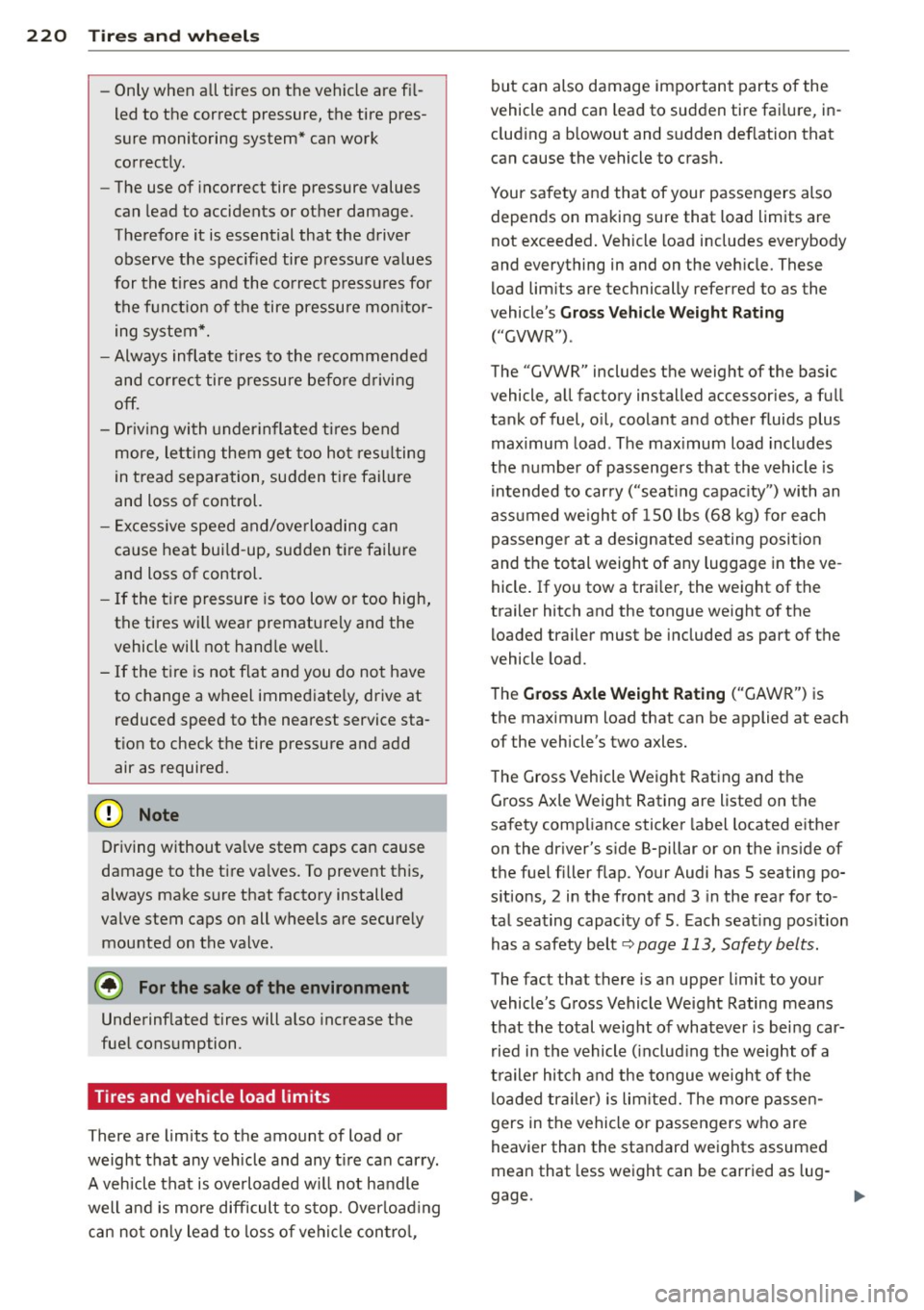
220 Tire s and wheel s
-Only when all tires on the vehicle are fi l
led to the correct pressure, the tire pres
sure monitoring system* can work correctly .
- The use of incorrect tire pressure values
can lead to accidents or other damage.
Therefore it is essential that the driver observe the specified tire pressure va lues
for the tires and the co rrect p ressu res fo r
the f unct ion of the tire pressure mo nitor
ing system*.
- Always inflate t ires to the recommended
and co rrec t tire pressu re before d rivi ng
off.
- Driv ing with under inflated ti res bend
more, lett ing them get too ho t res ulting
in tread separation, sudden t ire fail ure
and loss of control.
- E xcess ive speed and/overloading can
cause heat bui ld -up, sudden t ire fail ure
and loss of control.
- If the tire press ure is too low or too high,
the tires wi ll wear prematu rely and the
vehicle will not hand le we ll.
- If the t ire is no t flat and you do not have
to change a wheel immediate ly, drive at
reduced speed to the nearest service sta
t ion to check the tire pressure and add
air as required.
Driving without va lve stem caps can cause
damage to the tire va lves. To prevent this,
always make sure that facto ry installed
valve stem caps on all wheels are secure ly
mounted on the valve.
@) For the sake of the environment
Underinf lated tires will a lso increase t he
fue l consumption .
Tires and vehicle load limits
There are limits to the amount of load or
weight that any veh icle and any t ire ca n car ry .
A veh icle that is overloaded w ill not ha ndle
well a nd is more difficult to s top. Over load ing
c a n no t on ly lead to loss of veh icle con tro l, but can also damage important parts of the
vehicle and ca n lead to sudden tire fai lure, in
clud ing a b lowout and sudden deflation that
can cause the vehicle to crash.
Your safety an d that of your passengers also
depends on making sure that load limits are
not exceeded . Vehicle load includes everybody
and everything in and on the veh icle. These
load lim its are technically referred to as the
vehicle's
Gro ss Vehicle Weight Rating
("GVWR").
The "GVWR" includes the weight of the basic
vehicle, a ll factory installed accessories, a full
tank of fuel, o il, coolant and other fluids plus
maximum load. The max imum load incl udes
the number of passengers that the vehicle is
i ntended to car ry ("seat ing capac ity ") with an
a ss u med we igh t of 150 lbs (68 kg) for e ach
passenge r at a designated seating posi tion
and the total weight of any luggage in the ve
hicle . If you tow a trai ler, the weight of the
trai ler hitch and the tongue weight of the
loaded tra iler must be included as part of the
vehicle load.
T he
G ros s Axle Weight Rating ("GAWR") is
the maximum load that can be applied at each of the vehicle's two axles.
The Gross Vehicle Weight Rating and the Gross Ax le Weight Rating are listed on the
safety comp liance sticker label located e ither
on the dr iver's s ide B-pillar or on t he ins ide of
the fuel filler flap . Your Audi has 5 sea ting po
s itions, 2 in the front and 3 in the rear for to
tal seating capacity of 5 . Each seat ing pos ition
has a safety belt
q page 113, Safety belts.
The fac t that there is a n upper limit to your
vehicle's G ross Vehicle Weight Rating means
that the total weight of whatever is bei ng car
ried in the vehicle ( in cl ud ing the weight of a
t ra ile r hi tc h and the tongue we igh t of the
loaded trail er) is lim ite d. T he more p assen
gers in the vehicle or passengers who are
heavier than the standard weights assumed
mean that less weight can be carried as lug-
gage.
~
Page 233 of 280

remain continuously illuminated. This se
quence will continue upon subsequent vehicle
start-ups as long as the malfunction exists.
When the malfunction indicator is illuminat
ed, the system may not be able to detect or
signal low tire pressure as intended . TPMS
malfunct ions may occur for a variety of rea
sons, including the installation of replace
ment or alternate tires or wheels on the vehi
cle that prevent the TPMS from functioning
properly . Always check the TPMS malfunction
tellta le after replacing one or more tires or
wheels on your vehicle to ensure that the re
placement or alternate tires and wheels allow
the TPMS to continue to function properly.
Tire pressure indicator appears
Appl ies to vehicles: with tire pressur e monitoring sys te m
The tire pressure indicator in the instrument
cluster informs you if the tire pressure is too
low or if there is a system malfunction.
Fig. 172 Display : underinflation warning
Fig. 173 Display: System malfunction
Using the ABS sensors, the tire pressure moni
toring system compares the tire tread circum
ference and vibration characteristics of the in
dividual tires. If the pressure decreases in one
or more tires, this is indicated in the instru
ment cluster with a warning symbol
ti] and a
Tires and wheels 231
message r=!) fig. 172. The driver message in the
display goes out after 5 seconds. The driver
message can be displayed again by pressing
the
ICHECKI button @¢ page 10, fig . 3 . If on
ly one tire is affected, the display will indicate
its position .
The tire pressure monitoring must be reset in
the menu display each time the pressures are
adjusted (e .g. when switching between parti
al and full load pressure) or after changing or
replacing a tire on your vehicle¢
page 232.
You can find the recommended tire pressures
for your vehicle on the label on the driver's
door pillar¢
page 216.
Tire tread circumference and vibration charac
teristics can change and cause a tire pressure
warning if:
- the tire pressure in one or more tires is too
low,
- the tire has structural damage,
- the tire pressure was changed, wheels rotat- ed or replaced but the TPMS was not reset
¢page 232.
Warning symbols
ti] Loss of pressure in at least one tire¢&.
Check the tire or tires and replace or repair if
necessary. The indicator light
ti] in the instru
ment cluster also illuminates
¢page 13.
Check/correct the pressures of all four tires
and reset TPMS in the menu display .
11@1&1 (Tire Pressure Monitoring System) Tire
pressure! System malfunction . Ifll@IS, ap
pears after switching the ignition on or while
driving ¢
fig. 173 and the indicator light ti] in
the instrument cluster blinks for approx i
mately one minute and then stays on, there is
a system malfunction. See your autho rized
Audi dealer as soon as possible.
A WARNING
-If the tire pressure indicator appears in
the instrument cluster display, one or
more of your tires is significantly under
inflated. Reduce your speed immediately
and avoid any hard steering or braking ..,.
Page 234 of 280

232 Tires and wheels
maneuvers. Stop as soon as possible and
check the tires and their pressures. In
flate the tire pressure to the proper pres
sure as indicated on the vehicle's tire
pressure label ¢
page 216. Driving on a
significantly under-inf lated tire causes
the tire to overheat and can lead to tire
failure. Under-inflation also is likely to
impair the vehicle's handling and stop
ping ability.
- T he driver is responsible for maintain ing
the correct tire pressures. You must
check the tire pressures regularly.
- Under certain cond itions (such as a spor
ty driving style, winter conditions or un
paved roads), the pressure monitor indi
cator may be delayed.
- Ask your authorized Audi dealer if run
flat tires may be used on your vehicle .
Your vehicle registration becomes invalid
if you use these tires when not permit
ted. Damage to your veh icle or acc idents
could also result .
(D Tips
- The tire pressure monitoring system
stops working when there is an ESP/ABS malfunction .
- Using snow chains may result in a system
malfunction.
- Tires with the identification "AO" or "RO"
have been specially matched with your
Audi. We recommend using only these
tires because they meet the highest
standards regarding safety and driving
characteristics when used correctly. Your
a uthorized Audi dea ler will g ladly pro
v ide you w ith more information.
Reset tire pressure monitoring system
(Stepl)
Applies to veh icles: w ith tire pressure monitoring system
If the tire pressure is adjusted, wheels ore ro
tated or changed, the TPMS must be reset in
the menu display.
----- ®
Fig. 174 Wipe r lever: Contro ls fo r the menu d isplay
Fig. 175 Disp lay: S ta rt m enu
I Rese t I button @ and rocker switch @
¢ fig. 17 4 functions:
To open the menu
" Press the I Reset ! button @ unt il the menu
disp lay¢
fig. 175 appears
Selections and settings
" Press the rocker switch @ to reach a menu
d isp lay. The switch is operated the same as
the display (up/down) .
Entering and confirming
" Press the I Reset I button @.
Returning to the Start menu
" Press the I Rese t I button longer than 2 sec
onds to return from any menu level to the
Start menu.
Page 237 of 280

You will find the compact spare wheel under
the floor in the luggage compartment . It is
secured w ith a large nut.
Using the compact spare wheel
The compact spa re wheel is only intended for
emergenc ies until you can reach a repair shop .
Replace i t as quickly as possible with a normal
wheel.
There are some restrictions on the use of the
compact spare wheel~ &. . The compact spare
wheel has been developed especially for your
type of vehicle . It must not be exchanged for
the compact spare whee l from another type of
vehicle.
Normal summer or winter tires must not be
installed on the compact spare whee l rim.
Snow chains
For technica l reasons, the use of snow chains
on the compact spare wheel is
n ot permitted .
If you do have to dr ive w ith snow cha ins and
have a t ire failure on a
front wheel, insta ll the
spa re wheel in place of a rear wheel. Install
the snow chains on the rear wheel and use it
to replace the defective front whee l.
Using the spare wheel
The spare wheel is only intended for emergen
cies until you can reach a repair shop. Replace
it as qu ickly as possib le with a no rmal wheel.
There are some restrict ions on the use of a
spare wheel
Q &. . The spare wheel has been
developed especially for your type of vehicle.
It m ust not be exchanged for the spare whee l
from anot her type of vehicle.
Normal summer or winter tires must not be
i nstalled on the spare wheel rim.
Snow t ires
For technical reasons, the use of snow chains
on the spare whee l is
not p erm itte d.
If you do have to drive with snow chains and
have a t ire failure on a
front wheel, insta ll the
spare wheel in place of a rear wheel. Install
What do I do now? 235
the snow chains on the rear whee l and use it
to replace the defective front wheel.
A WARNING -
A lways store jacking equipment, spare
wheel in the luggage compartment. Tight
en screw for the spare wheel secure ly. Un
der no circumstances should you store the
spa re wheel o r jack and tools unsecured in
the passenger compartment . This could
cause ser ious persona l inju ry to passen
gers in the veh icle in case of a collision .
- The compact spare tire is for temporary
use only and is so marked on the side
walls .
- Do not dr ive at speeds exceeding SO mph
(80 km/h) wi th the compact spare whee l
mounted . A lso rapid acce lerat ion, ha rd
braking and hard cornering must be
avoided to he lp prevent loss of vehicle
contro l.
- Any continuous road use of the compact
spare tire may result in tire failure, loss
of vehicle control and injury to vehicle
occupants.
- Do not put a snow chain on your compact
spare tire. Due to the smaller t ire size,
the chain will not fit properly and can
thus damage your vehicle. You cou ld also
lose the chain, as well as contro l of the
veh icle .
- If you have a flat front t ire in road condi
tions which require snow chains, first re
move the undamaged rea r whee l and
mount the compact spare wheel in its
place. Then remove the damaged front
wheel, take the snow cha ins off it and at
tach them to the whee l taken from the
rear. This wheel can now be mounted on
the front with its snow chains. Check and
adjust t ire pressure promptly .
- Never use two or more compact spare
tires at the same time.
(D Note
When using the compact spare wheel, note the fo llowing: •
•
Page 238 of 280
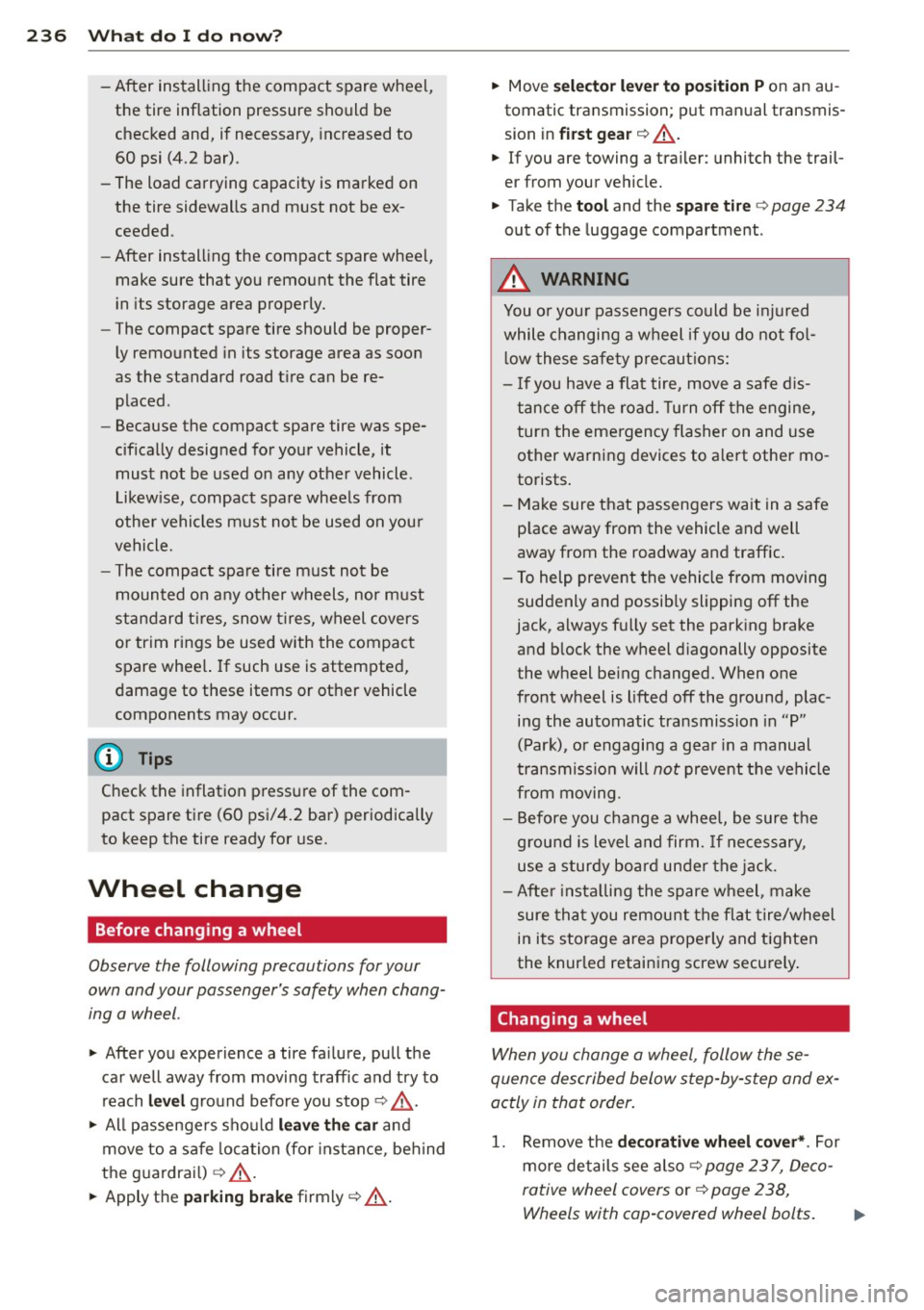
236 What do I do now?
-After installing the compact spare wheel,
the tire inflation pressure should be
checked and, if necessary, increased to
60 psi (4.2 bar).
- The load carrying capacity is marked on
the tire sidewalls and must not be ex
ceeded.
- After installing the compact spare wheel,
make sure that you remount the flat tire
in its storage area properly.
- The compact spare tire should be proper
ly remounted in its storage area as soon
as the standard road tire can be re placed .
- Because the compact spare tire was spe
cifically designed for your vehicle, it must not be used on any other vehicle .
Likewise, compact spare wheels from
other vehicles must not be used on your
vehicle.
- The compact spare tire must not be
mounted on any other wheels, nor must
standard tires, snow tires, wheel covers
or trim rings be used with the compact
spare wheel. If such use is attempted,
damage to these items or other vehicle
components may occur .
(D Tips
Check the inflation pressure of the com
pact spare tire (60 psi/4.2 bar) periodically
to keep the tire ready for use.
Wheel change
Before changing a wheel
Observe the following precautions for your
own and your passenger's safety when chang
ing a wheel .
.. After you experience a tire failure, pull the
car well away from moving traffic and try to
reach
level ground before you stop c:> ,&. .
.. All passengers should leave the car and
move to a safe location (for instance, behind
the guardrail)
c:> _&. .
.. Apply the parking brake firmly c:> _&. .
.. Move selector lever to position Pon an au
tomatic transmission ; put manual transmis
sion in
first gear c:> _&..
.. If you are towing a trailer : unhitch the trail
e r from your vehicle.
.. Take the
tool and the spare tire c:> page 234
out of the luggage compartment .
.&, WARNING
You or your passengers could be injured
while changing a wheel if you do not fol
low these safety precautions:
- If you have a flat tire, move a safe dis
tance off the road. Turn off the engine,
turn the emergency flasher on and use
other warning devices to alert other mo
torists.
- Make sure that passengers wait in a safe place away from the vehicle and well
away from the roadway and traffic .
- To help prevent the vehicle from moving suddenly and possibly slipping off the
jack, always fully set the parking brake
and block the wheel diagonally opposite
the wheel being changed. When one
front wheel is lifted off the ground, plac
ing the automatic transmission in "P"
(Park) , or engaging a gear in a manual
transmission will
not prevent the vehicle
from moving.
- Before you change a wheel, be sure the
ground is level and firm. If necessary,
use a sturdy board under the jack.
- After installing the spare wheel, make
sure that you remount the flat tire/wheel
in its storage area properly and tighten
the knurled retaining screw securely.
Changing a wheel
-
When you change a wheel, follow these
quence described below step-by-step and ex
actly in that order .
1. Remove the decorative wheel cover*. For
more details see also
c:> page 23 7, Deco
rative wheel covers
or c:> page 238,
Wheels with cap-covered wheel bolts.
Page 239 of 280
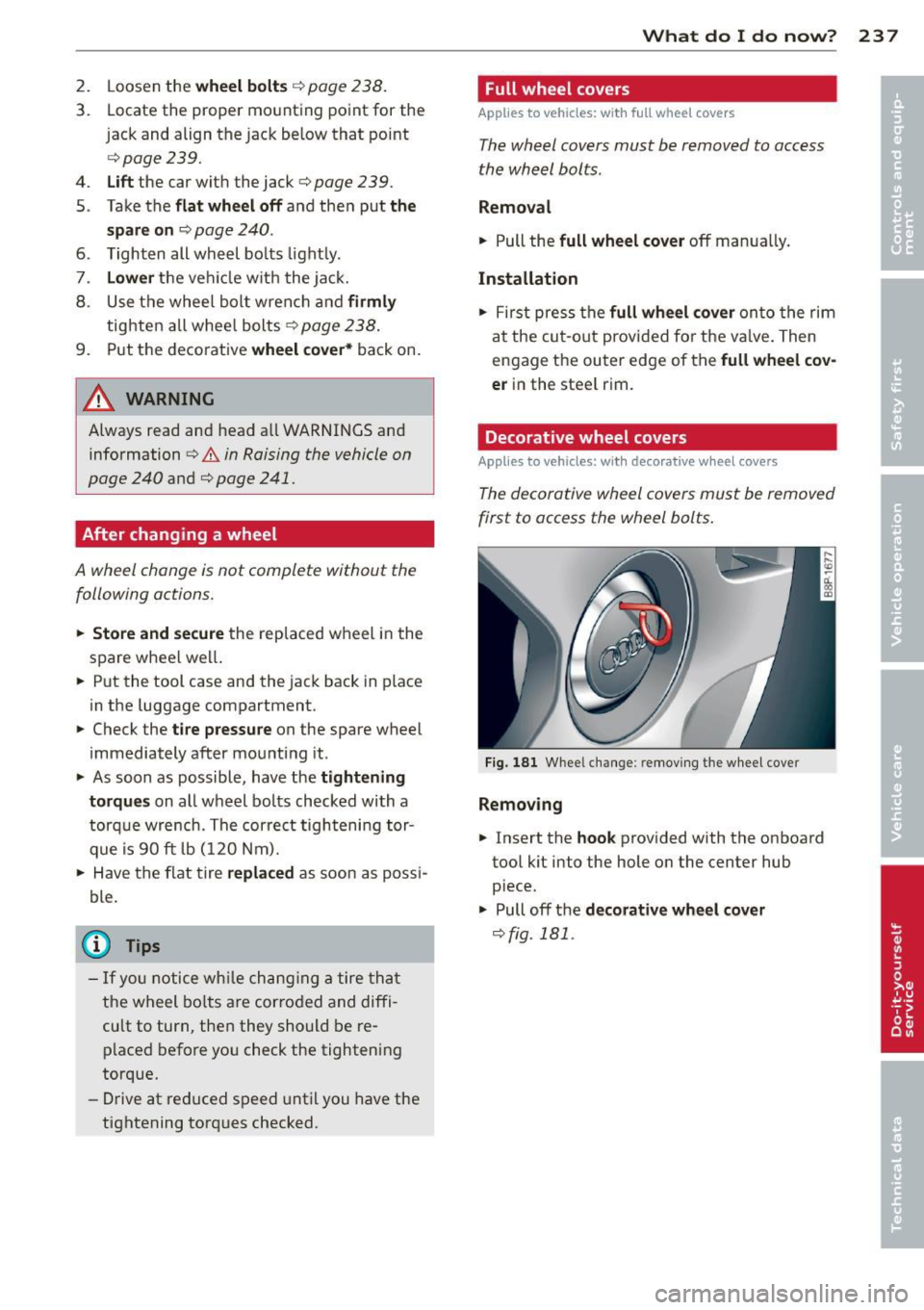
2. Loosen the w hee l bol ts ¢ page 238.
3. Locate the proper mounting point for the
jack and align the jack below that point
¢ page 239.
4. Lift the car with the jack¢ page 239.
5. Take the flat wheel off and then put the
spare on
¢ page 240 .
6. Tighten all wheel bo lts light ly .
7 .
Low er the veh icle w ith the jack.
8 . Use the wheel bolt wrench and
firml y
tighten all whee l bolts ¢ page 238.
9. Put the decorative wh eel cov er* back on.
A WARNING -
Always read and head all WARNINGS and
information
¢ A in Raising the vehicle on
page 240
and ¢ page 241.
After changing a wheel
A wheel change is not complete without the
following actions .
.. Store and secu re the replaced wheel in the
spare wheel we ll.
.. Put the tool case and the jack back in place
in the luggage compartment .
.. Check the
tir e pres su re on the spare wheel
immediately after mounting it .
.. As soon as possible, have the
tightening
torqu es
on all wheel bolts checked with a
torque wrench. The correct tightening tor
que is 90 ft lb (120 Nm).
.. Have the flat tire
repl aced as soon as possi
ble.
@ Tips
- If yo u n otice wh ile chang ing a tire tha t
the wheel bo lts a re cor roded and diffi
cult to turn, then they should be re placed before you check the tightening
torque.
- Drive at reduced speed until you have the
tightening torques checked .
What do I do now ? 237
Full wheel covers
App lies to vehicles : with ful l wheel cove rs
T he wheel covers must be removed to access
the wheel bolts.
Remo val
.. Pull the full whe el cover off manua lly.
Installation
.. First press the full w hee l cover on to the rim
a t the cut-o ut prov ided for the va lve . Then
engage the outer edge of the
full wheel cov
er
in the steel rim.
Decorative wheel covers
App lies to vehicles: with decorat ive w hee l covers
The decorative wheel covers must be removed
first to access the wheel bolts .
Fig. 181 Whee l cha nge : removing the whee l cover
Remo ving
.. Insert the hook provided with the on board
tool kit into the hole on the center hub
piece.
.. Pull off the
decorati ve wh eel cover
¢ fig . 181 .
Page 240 of 280
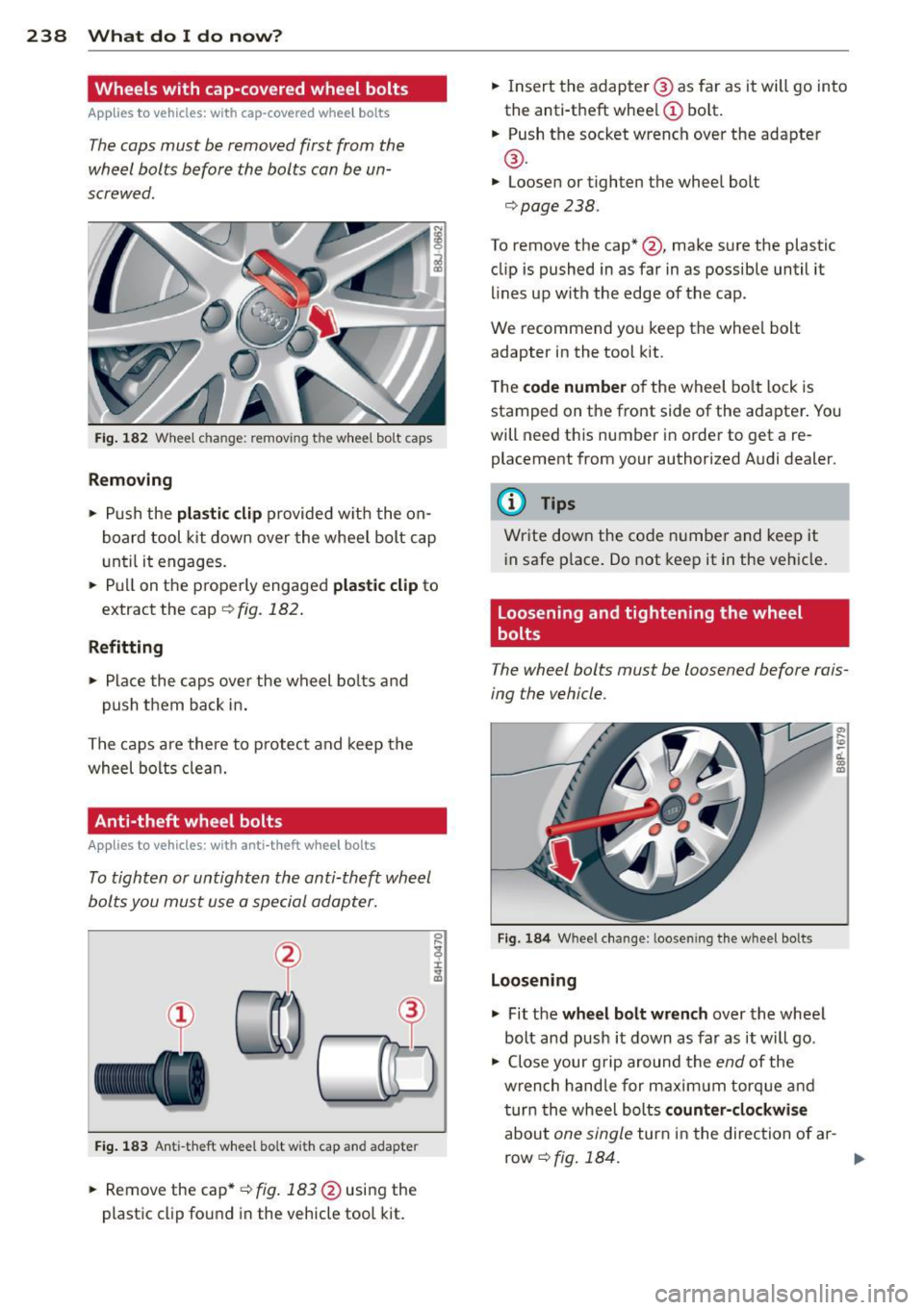
238 What do I do now?
Wheels with cap-covered wheel bolts
Applies to vehicles: wit h cap-cove red w hee l bo lts
The caps must be removed first from the
wheel bolts before the bolts can be un
screwed.
Fig. 182 Whee l change : removing the wheel bo lt caps
Removing
.,. Push the plastic clip provided w ith the on
board tool kit down over the wheel bolt cap
u nt il it engages .
.. Pull on the properly engaged
plastic clip to
extract the cap
¢ fig. 182 .
Refitting
.. Place the caps over the wheel bolts and
push them back in .
The caps are there to p rotect and keep the
wheel bolts clean.
Anti-theft wheel bolts
Applies to vehicles : wit h ant i-t heft wheel bo lts
To tighten or untighten the anti-theft wheel
bolts you must use a special adapter.
(~
'
Fig. 183 Anti-theft w hee l bo lt w it h cap and adapter
.. Remove the cap* ¢fig. 183 @using the
plastic clip found in the vehicle tool kit. ..
Insert the adapter @ as far as it will go into
the anti -theft wheel
CD bolt.
.. Push the socket wrench over the adapter
@ .
.. Loosen or tighten the wheel bolt
¢page 238.
To remove the cap* @, make sure the plastic
clip is pushed in as far in as possible until it
lines up with the edge of the cap .
We recommend you keep the whee l bolt
adapter in the tool kit.
T he
code number of the wheel bolt lock is
stamped on the front side of the adapter . You
will need this number in order to get a re placement from your authorized A udi dealer.
Q) Tips
Write down the code number and keep it
in safe place. Do not keep it in the vehicle.
Loosening and tightening the wheel
bolts
The wheel bolts must be loosened before rais
ing the vehicle.
Fig. 184 W hee l change : loosen ing the wheel bolts
Loosening
.,. Fit the wheel bolt wrench over the wheel
bolt and push it down as far as it will go .
"' ...
.,. Close your g rip around the end of the
w rench handle for maximum torque and
turn the wheel bolts
counter-clockwise
about one single turn in the direction of ar-
row ¢
fig. 184. .,.
Page 241 of 280
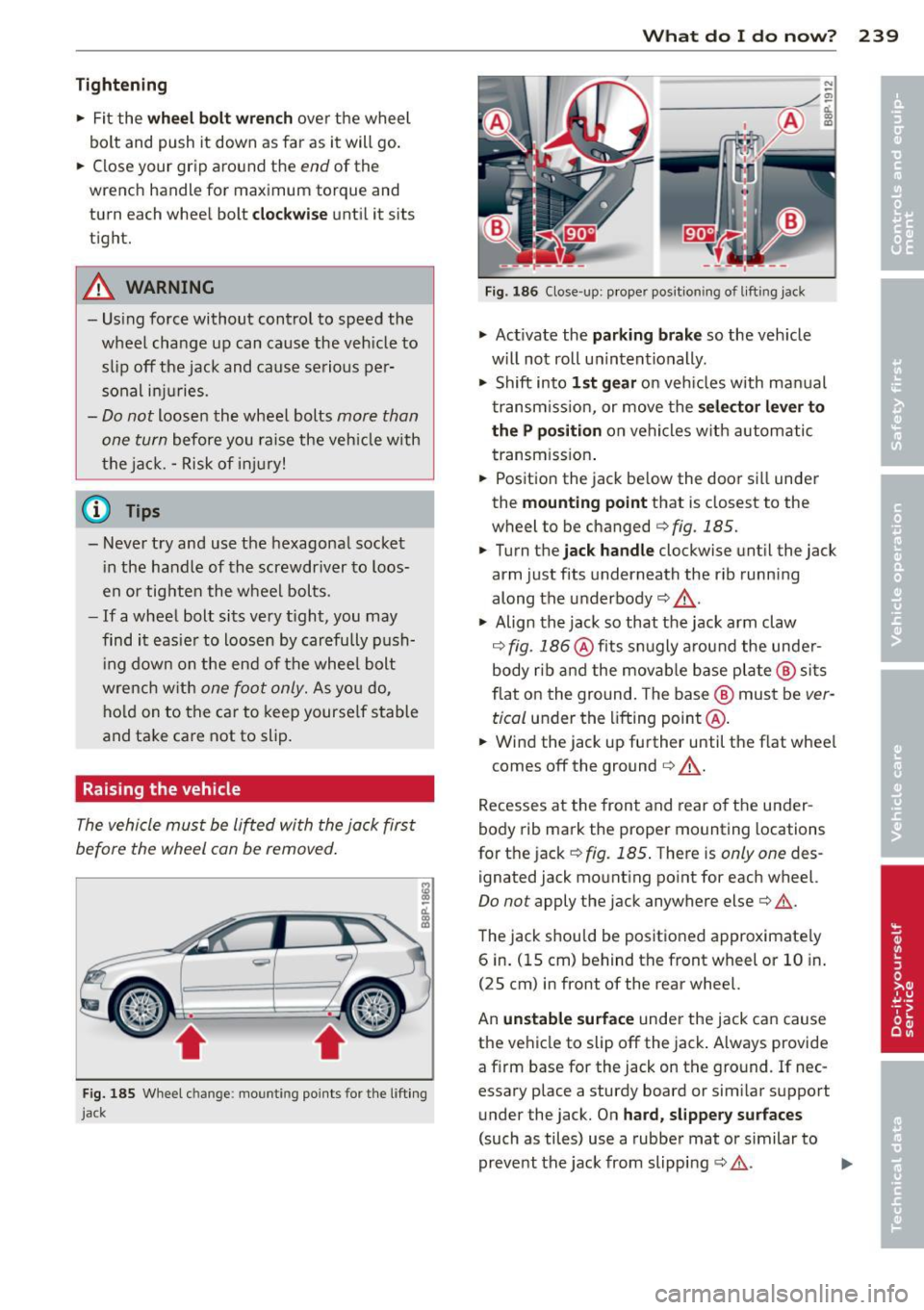
Tightening
• Fit the wh eel b olt wren ch over t he wheel
bolt and push it down as far as it will go .
• Close your gr ip aro und the
end of the
wrench handle for maximum torque and
turn each whee l bolt
cl ock wise until it sits
tight.
A WARNING
- Us ing force without control to speed the
wheel change up can cause the veh icle to
slip off the jack and cause serious pe r
sonal inj uries.
- Do not loosen the wheel bolts more than
one turn
before you ra ise the veh icle with
the jack. -Risk of inj ury!
@ Tips
- Never t ry and use the hexagonal socket
i n the handle of the screwdriver to loos
en o r tighten the wheel bolts .
- If a wheel bolt sits very t ight, you may
find it easie r to loosen by carefully push
i ng down on the end of the whee l bolt
wre nch w ith
one foot only. As you do,
ho ld on to the ca r to keep yourse lf stable
and ta ke care not to slip .
Raising the vehicle
The vehicle must be li~ed with the jack first
before the wheel can be removed .
Fig. 185 W heel c hange: mo untin g po ints for the lift ing
j ac k
What do I d o now ? 239
Fig. 1 86 Close -up: p roper pos ition ing o f lift in g jack
• Act ivate the parking brak e so the vehicle
w il l not roll u nintentionally .
• Shift into
1st gear on vehicles with manual
transm iss ion, or move the
se lecto r l ev e r to
the P p ositio n
on vehicles with automatic
transm ission .
• Pos it ion the jack be low the door sill under
the
mounting point that is closest to the
wheel to be changed
r=> fig. 185.
• Turn the jack handle clockwise unt il the jack
arm just fits underneath the rib running
along the underbody
c::> & ..
• Align the jack so that the jack arm claw
c:;, fig. 186 @fits snugly around the unde r
body rib and the movab le base plate ® sits
flat on the ground. The base @ must be
ver
tical
under the lifting point @.
• Wind the jack up further until the flat wheel
comes off the ground
c::> . & ..
Recesses at the front and rear of the under
body rib mark the proper mo unting locations
for the jack
c:;, fig. 185 . There is only one des
ignated jack mounting po int for each wheel.
Do not apply the jack anywhere else c::> .&. .
The jack shou ld be positioned approximate ly
6 in. (15 cm) behind the front wheel or 10 in.
(25 cm) in front of the rear wheel.
An
unstable surfa ce under the jack can cause
the vehicle to slip off the jack . Always provide
a firm base for the jack on the ground . If nec
essary place a sturdy board or sim ilar support
under the jack. On
hard , slipper y su rf a ces
(such as tiles) use a rubber mat or similar to
prevent the jack from slipp ing
c::> .&. . .,.